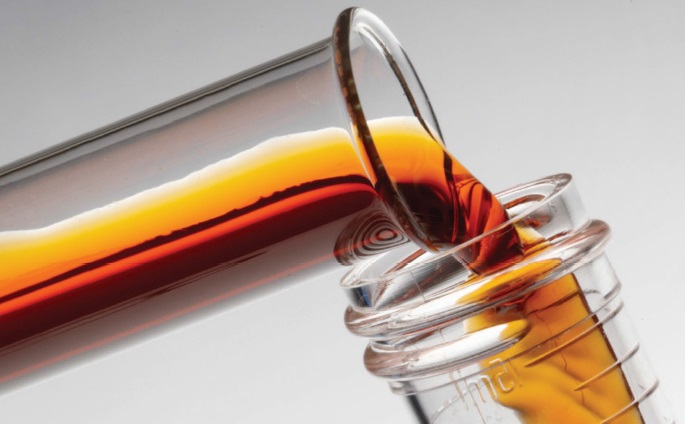Basestock Evolution
Jean Van Rensselar, Contributing Editor | TLT Feature Article October 2012
Improved technology, higher performance drive surge toward Groups II, III and IV.

www.canstockphoto.com
KEY CONCEPTS
•
Relatively new basestock technologies are significantly improving the performance of Group II and Group III basestocks.
•
This new technology allows Group II and Group III basestocks to rival PAOs on some aspects of performance.
•
These new technologies are causing a seismic shift in demand between Group I and Group III basestocks.
Demanding lubrication performance, previously only possible with PAOs, is now achievable with cutting-edge Group II and Group III basestock. Also, as technology advances, basestock alone (without additives) is becoming increasingly capable of satisfying the basic functions of lubricating oils such as reducing friction and wear, inhibiting rust and corrosion and removing/reducing contaminants.
In the past, improved lubricant performance was largely dependent on advances in additive technology, but this is changing. Though dormant for decades, the basestock industry is catching up in regards to innovation. In the 1960s because of new technologies, mainly hydroprocessing, basestock purity and performance improved dramatically. In the 1970s and 1980s, Group II basestock became commercially available, and in 1993 it was recognized as a separate API category. Groups III and IV followed shortly. Since then there has been a demand shift from Group I to Group II and Group III basestock, which can be much more economical.
BASESTOCK TREATMENT
There are two basic choices for refining crude into basestock: traditional solvent treating and the continuously evolving hydroprocessing technologies.
Solvent treating, introduced in the 1920s, is still a widespread method for refining lubricants. Once the feedstock is distilled and separated into components based on their boiling-point range (yielding light oils), impurities such as sulfur, oxygen, nitrogen and salts remain. Solvent extraction and solvent dewaxing, which are intermediate refining processes, remove these impurities.
Solvent Extraction. Solvent extraction prevents corrosion, protects the catalyst in subsequent refining processes and improves finished products by removing unsaturated, aromatic hydrocarbons from lubricant feedstock. The feedstock is sent to a vacuum distillation tower where lubricants of specific viscosity index (VI) ranges are created. These products are individually treated in a solvent extraction tower where the solvent is mixed with the lubricant fractions. This process removes up to 80% of the aromatic hydrocarbons and other impurities.
The most common extraction solvents are phenol, furfural and cresylic acid. The selection of specific chemical agents and processes depends on a number of factors such as the nature of the feedstock being treated, the contaminants and finished product specifications.
Solvent Dewaxing. Solvent dewaxing removes wax from either distillate or residual basestock at any refining stage. The three basic solvent dewaxing steps include (1.) mixing the feedstock with a solvent, (2.) precipitating the wax from the mixture by chilling and (3.) recovering the solvent (for recycling) from the wax and dewaxed lubricant through distillation and steam-stripping.
API Basestock Classifications
The American Petroleum Institute (API) categorizes basestocks by their sulfur content, level of saturates and viscosity index (VI). There are five API basestock classifications:
•
Group I solvent Dewaxed Basestock is the least refined—usually a mix of different hydrocarbon chains. These oils are generally used in applications without high performance demand but have significant advantages when it comes to additives.
•
Group II Hydroprocessing and Refining Basestock is common in commercial mineral-based motor oils. They perform acceptably in terms of volatility, oxidative stability and flash/fire points but not as well in terms of cold-start viscosity, extreme pressure durability and pour point. Greater purity means that the basestock and the additives in the finished product will last much longer.
•
Group III Hydroprocessing and Refining Basestock is the most refined of all mineral oil basestock. It performs well in many regards and is highly stable. Lubricants formulated with this basestock are often synthetic or semisynthetic. Group III basestock is manufactured using the same hydroprocessing techniques as Group II basestock. The difference is that the processes are stepped up in order to yield a higher VI. Today’s Group III basestock performs as well or better than traditional synthetic oils.
•
Group IV or PAO (Polyalphaolefin) Basestock is a chemically engineered synthetic. It has a highly stable chemical composition and is increasingly present in synthetic and synthetic-blend products for industrial and vehicle applications.
•
Group V Basestock is usually blended with other basestock. It is used in small amounts as secondary basestock to impart discrete lubricant properties. This basestock is capable of accommodating a wide variety of properties and custom packages. Because of this, it provides the base ingredient for many additives.
HYDROPROCESSING
Hydroprocessing is largely the cause of the basestock revolution. Hydroprocessing opens up a wider selection of crude oils for making higher quality basestock. Because of hydroprocessing and the resulting stability and purity, Group II and Group III basestock have become the norm—reducing the near monopoly Group I basetock had on the lubricant market for decades.
Today, hydroprocessing is employed in more than 50% of finished basestock in North America—the figure is probably higher in Europe. Following are the most common hydroprocesses:
Hydrotreating. Hydrotreating involves adding hydrogen to the basestock at high temperatures and under high pressure in the presence of a catalyst. This process yields benefits that include purification, stabilization and greater longevity. Hydrotreating alone is usually not enough to make a quality basestock.
Hydrocracking. Hydrocracking is an intense version of hydrotreating that involves significantly higher temperatures and greater pressure. The process name is derived from the fact that some feed molecules are cracked into smaller molecules. During hydrocracking nearly all sulfur and nitrogen is removed, while aromatic compounds become hydrogensaturated.
Catalytic Dewaxing. Waxy compounds, which are usually unaffected by hydrocracking, need to be removed separately with catalytic dewaxing in order to reduce pour point. This is also a high-temperature, high-pressure process. Catalytic dewaxing uses a catalyst that selectively cracks the wax molecules in the basestock. Among the end products are clean fuels such as diesel, and naphtha.
Wax Hydroisomerization. In wax hydroisomerization, the wax is
selectively converted into very high quality basestock rather than being converted to lower value products. While both catalytic dewaxing and wax hydroisomerization remove wax (lower basestock pour point), hydroisomerization also results in a basestock with a higher VI. Hydroisomerization yields performance that can be compared to a PAO-based synthetic lubricant at a significantly reduced cost.
Hydrofinishing. This is the final process, which involves high pressure and complex catalysts that convert any remaining contaminants/impurities into stable basestock molecules.
HYDROTREATING ADVANTAGES
There are significant advantages to hydrotreating. Following are characteristics and differences in basestock resulting from the two processes:
1.
Viscosity Index: Hydrotreated basetock generally has a higher VI than solvent refined basestock. This means the viscosity of hydrotreated basestock diminishes less at high temperatures than solvent refined basestock.
2.
Carbon Residue: There is less carbon residue in hydrotreated basestock.
3.
Total Acid Number: TAN is lower in hydrotreated basestock.
4.
Demulsibility: Hydrotreated basestock sheds water better than solvent-refined basestock.
5.
Oxidation Resistance: When treated equally with antioxidants, hydrotreated basestock resists oxidation better than solvent refined basestock.
6.
High Temperature Stability: Hydrotreated basestock has high temperature stability that is superior to solvent refined basestock.
7.
Color: All two-stage hydrotreated basestock is clear and colorless.
Unlike solvent refining, hydrotreating virtually eliminates all aromatics. Because of this, hydrotreated basestock can be termed 99.5% pure, while solvent-refined basestock is roughly 80% pure.
Shifting Basestock Demand (1,2)
“The rate of Group I refinery closures seems to have slowed over the past couple of years or so,” says Ian Macpherson, senior marketing manager for Afton Chemical Corp. “The value of some of the specialty products that are produced by some of these Group I refineries (such as brightstocks, etc.) may have now increased sufficiently to make the Group I refinery economics more appealing—time will tell.”
A 2009 study by Kline and Co. concluded that demand for API Group II base oil is steadily displacing Group I in automotive and industrial applications. The Kline study forecasts growth for niche players focused on specialty products entering the Group I market—process oils and waxes rather than basestock.
In discussing the study during a Web presentation, Milind Phadke, project manager for Little Falls, N.J.-based, Kline’s Energy Practice said that both supply and demand of API Group I basestock has steadily declined over the last 10 years, adding that this is primarily due to technical obstacles of Group I basestock for automotive applications (Group I basestock can no longer be used in most passenger car motor oils and heavy-duty motor oil applications). Because of this, many Group I producers are faced with the decision to either shutter or shift production to a higher Group.
Not surprisingly, this has had the effect of increasing demand for Group II and III basestocks significantly. Phadke points out that the increasing demand has led to increased supply, which has led to a surplus of Group II basestock, leading to this basestock being used in applications where Group I basestock would suffice. The Kline Study also predicts that Group III demand will nearly double between 2009-2019.
ADDITIVE SOLUBILITY AND RESPONSE
Nearly all finished lubricants, regardless of basestock, contain additives. Because of the absence of aromatics and polynaphthenes, newer basestocks are more oxidatively stable, but the removal of sulfur can negate that advantage. Metalworking fluids, for example, contain a relatively large percentage of additives in order to optimize performance.
STLE-member Tyler Housel, CLS, business director for Lexolube Synthetic Esters, Inolex Chemical Co. in Philadelphia, says, “Basestocks and additives work together, so it is almost impossible to develop one without paying attention to the other. As a supplier of synthetic ester basestocks, we must be experts in the additive technology that works with synthetic esters since it can be quite different from the wellknown additives used in hydrocarbon oils. There is really a surprising amount of synergy between basestock and additives.”
The choice of basestock affects additive performance in two regards: solubility and response. While these issues remain, technology, in terms of formulation and chemistry, exists to overcome them.
Generally speaking, as the level of hydrotreatment increases, additive solubility decreases. This is one of the biggest issues for finished products with Group II and Group III basestock. For example, performance of antiwear and extreme pressure additives is dependent on their ability to adsorb correctly on the machine surface. Basestock with poor solubility characteristics may allow these additives to separate before they can accomplish their functions. Conversely, basestock with very high-solubility characteristics may keep the additives in solution, not allowing them to adsorb (
3).
Basestocks also affect additive response. Contaminants and natural inhibitors, such as sulfur, are removed during basestock refining. The problem is that the removal of inhibitors can compromise additive performance. While synthetic basestock often has excellent additive response, it has a problem with additive solubility. The solubility characteristics of Group II and Group III basestock are very different than those of mineral basestock.
Workarounds include the development of new additives and reduced treat rates. One of the main reasons for mineral/ synthetic blends is the tendency for mineral basestock to be more compatible with additives. Expert blending can lead to excellent additive solubility and response. Another timetested formulation trick is to use synthetic esters in a PAO or Group III formula to add polarity, which greatly improves the effectiveness of the additives.
“Additives and base oils often have to be optimized in order to extract the full potential,” says STLE-member Ian Macpherson, senior marketing manager for Afton Chemical Corp. in Richmond, Va. “While R&D groups developing new base oils and new additives appear to be striving for the same goals, they are, in fact, mutually dependent.”
Chevron’s ISO Processes (4)
Chevron invented modern hydrocracking more than 40 years ago. Chevron’s all-hydroprocessing, iso-technology selectively concentrates and changes the molecular structure of wax into desirable isoparaffins. This allows refiners to maximize product yields and maximize product qualities. Chevron’s 3-step, iso-hydroprocessing route includes: ISOCRACKING,™ ISODEWAXING, ™ and ISOFINISHING.™
ISOCRACKING (To Increase VI)
Chevron’s proprietary hydrocracking process, ISOCRACKING, improves VI by chemically converting low VI components to higher VI basestock. Unlike older solvent refining processes that produce raffinate (
5) and a highly aromatic, low-value extract, the byproducts of ISOCRACKING include valuable fuels such as gasoline and diesel. For feedstock, ISOCRACKING creates higher VI components and preserves more molecules in the basestock boiling range than solvent refining. This gives refiners the flexibility to produce a higher basestock yield for a specific VI or a higher product VI at an equivalent yield level. ISOCRACKlNG allows refiners to maximize feedstock flexibility and product performance.
ISODEWAXING (To Reduce Pour Point)
Chevron’s ISODEWAXING technology was commercialized in 1993. Unlike solvent dewaxing, which removes the wax, ISODEWAXING catalytically changes the molecular structure of the wax into isoparaffins. This results in high VI, low pour points and superior resistance to oxidation. It also preserves the basestock’s waxy-ness and produces higher product VI and/or higher yields than other dewaxing processes. ISODEWAXING accommodates a broader range of feeds, which can be processed into a broader range of products. Additionally, it can process feeds with close to 100% wax in a single process (without recycling unconverted wax). Refiners using ISODEWAXING produce basestock with a VI ranging from 95 to 140 and beyond. Pour points range from low (-9 C to -15 C) to ultra-low (< -40 C).
ISOFINISHING (To Improve Oxidation Stability and Color)
ISOFINISHING, which can be used as a stand-alone process, rounds out Chevron’s proprietary hydrofinishing technologies. In 1984 the company introduced hydrofinishing that uses noblemetal catalysts rather than base-metal catalysts. Noble-metal catalysts provide higher activity at lower temperatures than base-metal catalysts. This produces higher quality basestock. The higher activity allows refiners to operate smaller reactors at lower pressures for improved efficiencies. The color of the resulting basestock is also superior.
CURRENT BASESTOCK CAPABILITIES
In the mid-1990s, new basestock-processing technology led to smarter plant design, which led to greater manufacturing flexibility and much lower operating costs. This new technology also offered:
•
Greater crude source adaptability
•
Better lubrication (higher VI)
•
Better thermo-oxidative stability
•
Better low temperature performance.
Today’s Group III basestock can perform better than Group IV PAOs when it comes to solubility, antiwear and lubricity properties, but it comes up short in other areas such as pour point, cold-temperature performance and oxidative stability.
Pour Point. Right now Group III basestock can only match PAO basestock pour point properties with additives. Basestock that is isomerization-treated will accept a pour point depressant—putting it on equal footing with PAOs.
Cold-Temperature Performance. While Group III basestock works well for engine lubricants in the 5W-20 to 10W-40 range, for 0W-20 and 0W-30 engine oils, which have extreme low-temperature performance capabilities, PAO basestocks are the primary choice.
Oxidative Stability. Oxidative and thermal stability are two of the most important advantages of PAO over Group III basestock, but hydroprocessing is evening this out, especially in high-temperature applications. With hydroprocessing and additives, even Group II basestocks can compete on oxidative stability with some synthetics.
STLE-member Doug Hiple, lubricant & metalworking industry manager for Monson Companies, Inc., in Leominster, Pa., says. “It depends on the basestock, but generally ester chemistry allows greater use of additives as opposed to mineral oils. The push by ester producers is toward developing higher performing basestocks. I don’t think there is competition between basestock and additive developers. Both are constantly looking toward solving issues with their chemistries. I suppose the ideal would be coordination between basestock and additive producers.”
NEW PRODUCTS
There are a number of relatively new basestocks on the market that offer excellent performance at an increasingly competitive price. These include Dow Chemical’s UCON™ OSP, Mitsui Chemicals’ Lucant,™ and ConocoPhillips Ultra-S.®
Dow Chemical’s UCON™ OSP. UCON OSP (oil-soluble polyalkylene glycol) basestock can be used as either supplemental basestock or additives—combining the advantage of PAGs and hydrocarbon oils. When paired with mineral oils, this basestock promises improved deposit control, oxidation stability, high viscosity index and low temperature stability. When used in additives, it offers excellent friction control in formulations that contain mineral oils and PAOs.
Applications include industrial air compressor fluids, greases, gear lubricants, industrial hydraulic fluids, fire-resistant hydraulic fluids and metalworking fluids.
Mitsui Chemicals’ Lucant.™ Mitsui’s LUCANT is a hydrocarbon- based synthetic basestock that has no polar groups and is a co-oligomer of ethylene and olefin. It has excellent resistance to heat and cold and low viscosity dependence on temperature performance.
In addition, it is non-volatile, colorless and transparent, has excellent heat and oxidation stability, a low pour point and high flash and fire points. Because it is chemically stable, it causes little or no metallic corrosion. This product is perfect for applications that involve rubber—where it functions as an oil extender and process-ability improver in applications that require heat, cold and volatility resistance and resins—where it acts as a softening and process agent.
ConocoPhillips Ultra-S. ® ConocoPhillips Ultra-S® basestocks are produced using an advanced hydrocracking and hydroisomerization process. The resulting API Group III basestocks are fully saturated and extremely pure, with very low volatility and high viscosity index.
With VIs of 120 to 130, very low volatility and excellent cold temperature and oxidation properties, the performance approaches that of PAOs. This highly purified basestock is extremely stable and highly resistant to oxidation—making it ideal in applications requiring longer service life under high temperature operating conditions.
 In the mid-1990s, new basestock-processing technology led to smarter plant design, which led to greater manufacturing flexibility and much lower operating costs.
EMERGING TECHNOLOGIES
In the mid-1990s, new basestock-processing technology led to smarter plant design, which led to greater manufacturing flexibility and much lower operating costs.
EMERGING TECHNOLOGIES
The trend is toward basestock with greater purity, lower volatility, better lubrication performance and longer life. This is accomplished mainly through improved processes, better hydroprocessing catalysts and better feedstock (quality and type).
While new feedstocks for PAOs are on the horizon, current PAO feedstock prices may continue to increase—further opening the door to Group II basestock with nearly equivalent properties and significantly lower prices. Beyond this, abundant availability of Group II and III mineral oil is spurring the decline of PAO and the rise of Group II and Group III basestock.
Catalytic dewaxing, which has enabled an abundant supply of Group II oils that have exceptional stability and low temperature performance, is now used to make about onethird of all basestock in North America. Group III basestock, processed by hydroisomerization, offers most of the performance advantages of traditional PAOs, but can be manufactured in volumes PAOs can’t touch. Despite this, experts say that there will always be a market for top-performing PAOs.
Holly Daley, senior vice president, industrial specialty group for Monson, explains, “I think those that use industrial process oils will stay with petroleum-derived products, but those that use MWFs may need the higher performance characteristics and properties of synthetics. So there is really a market for both. It is a significant investment for refiners of Group I and Group II basestock to be able to kick it up to the next level in terms of quality and even product consistency.”
RECYCLABILITY
Considering that it takes about 42 gallons of crude oil to produce 2. gallons of lubricant and that it takes one gallon of used oil to produce the same amount of lubricant, there are obvious environmental benefits to recycling used oil back into basestock (
6).
In the past, recycling used oil into basestock wasn’t very practical, but new technologies, which are producing higher quality end-products for less money, are changing that. Recycling has moved beyond just removing the water and basic impurities to removing heavy metals, nitrogen, chlorine and oxygenated compounds. This produces a basestock that can be recycled many times (
7).
BIOBASED FUELS AND LUBRICANTS
The recent drought in the U.S. points to price and availability concerns with biobased fuels and lubricants. Despite this and other issues, such as food versus fuel, biobased fuels and lubricants still hold the promise of a strong market. This is especially true in environmentally sensitive applications where eco-protection far outweighs price concerns.
Macpherson says, “Cost has historically sometimes been a limitation around base oils derived from vegetable sources, so I would not expect that recent crop cost and availability issues would be ignored—though long-term cost trends may be more significant. In many respects, the primary driver for new synthetic base oils is performance and not cost.”
Following are advantages of using biobased fuels and lubricants (
8):
•
Naturally better lubrication
•
Better viscosity/pressure performance
•
Superior thin film strength
•
Excellent viscosity index
•
Lower volatility
•
High flash/fire points.
And the following disadvantages:
•
If untreated, it lacks oxidative stability
•
If untreated, it has a high pour point
•
It is generally more expensive than petroleum.
The keys to overcoming these disadvantages lie in: (1.) genetic seed oil enhancement, (2.) breeding techniques that yield more stable feedstock, (3.) advances in chemical modification techniques and (4.) better or improved additive technologies.
Daley says, “Since we are a distributor and not a manufacturer, our customers are further down the supply chain, but I’m sure major users are very concerned about price and availability fluctuations of some feedstocks and are looking for alternatives.”
FINALLY…
The goal is to produce basestock with higher purity, lower volatility and longer life—largely by altering the molecular structure of the basestock. This can be supported through process improvements, improved hydroprocessing catalysts and higher quality feedstocks.
But even with significant advances in Group II and Group III basestock, the market for PAOs is still strong. According to Macpherson, “Power density and fuel economy have been major performance drivers in the top-tier lubricant sectors for many years. There are many examples where synthetic base oil was needed to reach the new performance heights being demanded. These same drivers are still present as smaller and smaller equipment is being designed to transmit higher and higher power with less lubricant.”
In addition to GTL (gas-to-liquid) basestock (
see sidebar), other promising technologies will emerge as well. Experts say that lifetime lubrication capabilities could one day be realized through Group II and Group III basestock and advanced additives.
Gas-to-Liquid Basestock
GTL (gas-to-liquid) is a process that converts natural gas into synthetic oil, which is then processed into hydrocarbon-based products that include fuels and lubricants. The process involves pulling natural gas molecules apart and reconstructing them into longer chain molecules that are similar to petroleum. The process results in a highly purified synthetic crude that is free of contaminants.
ISO paraffin is the lubricant basestock produced by GTL and is an alternative for Group III and IV lubricant basestocks. ISO paraffins have good viscosity properties, oxidative resistance and low-temperature capabilities. Theoretically, GTL could convert a significant portion of the world’s gas reserves into enough fuel to supply global energy needs for the next 25 years.

“The only way to produce an excellent finished product is to choose both the basestock and additives carefully,” Housel explains. “I can cite multiple examples where we felt very confident that a synthetic ester basestock would give outstanding performance and were surprised to hear that the customer saw little benefit. After discussion, we usually learn that they used their standard additive package, which was intended for a different basestock. After matching the additives to the basestock, the superior performance finally comes out.”
REFERENCES
1.
From
here.
2.
For more information on the study, visit
here.
3.
From
here.
4.
From
here.
5.
Raffinate is material that results from a chemical or mechanical process after a desired chemical or material is removed.
6.
From
here.
7.
ibid
8.
From
here.
 Jean Van Rensselar heads her own communication/public relations firm, Smart PR Communications, in Naperville, Ill. You can reach her at jean@smartprcommunications.com
Jean Van Rensselar heads her own communication/public relations firm, Smart PR Communications, in Naperville, Ill. You can reach her at jean@smartprcommunications.com.